Comparison of the Water Vapor Budget Evolution of Developing and Non-Developing Disturbances over the Western North Pacific
Abstract
:1. Introduction
2. Materials and Methods
2.1. Data
2.2. Identification of Developing and Non-Developing Disturbances
2.3. Water Vapor Budget Equation
2.4. Box Difference Index
3. Basic Characteristics of Disturbances
4. Water Vapor Budget of Developing and Non-Developing Disturbances
4.1. TPW
4.2. Evaporation
4.3. Moisture Flux Convergence
4.4. Precipitation
4.5. Analysis of BDI
5. Conclusions and Discussion
Author Contributions
Funding
Data Availability Statement
Acknowledgments
Conflicts of Interest
References
- Emanuel, K. Tropical Cyclones. Annu. Rev. Earth Planet. Sci. 2003, 31, 75–104. [Google Scholar] [CrossRef]
- Emanuel, K. 100 Years of Progress in Tropical Cyclone Research. Meteorol. Monogr. 2018, 59, 15.1–15.68. [Google Scholar] [CrossRef]
- Fu, B.; Peng, M.S.; Li, T.; Stevens, D.E. Developing versus Nondeveloping Disturbances for Tropical Cyclone Formation. Part II: Western North Pacific. Mon. Weather Rev. 2012, 140, 1067–1080. [Google Scholar] [CrossRef]
- Hennon, C.C.; Papin, P.P.; Zarzar, C.M.; Michael, J.R.; Caudill, J.A.; Douglas, C.R.; Groetsema, W.C.; Lacy, J.H.; Maye, Z.D.; Reid, J.L.; et al. Tropical Cloud Cluster Climatology, Variability, and Genesis Productivity. J. Clim. 2013, 26, 3046–3066. [Google Scholar] [CrossRef]
- Peng, M.S.; Fu, B.; Li, T.; Stevens, D.E. Developing versus Nondeveloping Disturbances for Tropical Cyclone Formation. Part I: North Atlantic. Mon. Weather Rev. 2012, 140, 1047–1066. [Google Scholar] [CrossRef]
- Gray, W.M. Global View of the Origin of Tropical Disturbances and Storms. Mon. Weather Rev. 1968, 96, 669–700. [Google Scholar] [CrossRef]
- Fu, B.; Li, T.; Peng, M.S.; Weng, F. Analysis of Tropical Cyclogenesis in the Western North Pacific for 2000 and 2001. Weather Forecast. 2007, 22, 763–780. [Google Scholar] [CrossRef]
- Ritchie, E.A.; Holland, G.J. Large-Scale Patterns Associated with Tropical Cyclogenesis in the Western Pacific. Mon. Weather Rev. 1999, 127, 2027–2043. [Google Scholar] [CrossRef]
- Wu, L.; Zong, H.; Liang, J. Observational Analysis of Tropical Cyclone Formation Associated with Monsoon Gyres. J. Atmos. Sci. 2013, 70, 1023–1034. [Google Scholar] [CrossRef]
- Zong, H.; Wu, L. Synoptic-Scale Influences on Tropical Cyclone Formation within the Western North Pacific Monsoon Trough. Mon. Weather Rev. 2015, 143, 3421–3433. [Google Scholar] [CrossRef]
- Chen, G.; Chou, C. Joint Contribution of Multiple Equatorial Waves to Tropical Cyclogenesis over the Western North Pacific. Mon. Weather Rev. 2014, 142, 79–93. [Google Scholar] [CrossRef]
- Feng, X.; Yang, G.-Y.; Hodges, K.I.; Methven, J. Equatorial Waves as Useful Precursors to Tropical Cyclone Occurrence and Intensification. Nat. Commun. 2023, 14, 511. [Google Scholar] [CrossRef] [PubMed]
- Wu, L.; Takahashi, M. Contributions of Tropical Waves to Tropical Cyclone Genesis over the Western North Pacific. Clim. Dyn. 2018, 50, 4635–4649. [Google Scholar] [CrossRef]
- Yu, R.; Gao, S.; Sun, L.; Chen, G.; Shen, X. Multiscale Mechanisms for the Modulation of the Pacific Meridional Mode on Tropical Cyclone Genesis over the Western North Pacific: A Comparison between 2004 and 2011. Clim. Dyn. 2023, 60, 3241–3259. [Google Scholar] [CrossRef]
- McBride, J.L. Tropical cyclone formation. In Global Perspectives on Tropical Cyclones; Elsberry, R.L., Ed.; World Meteorological Organization: Geneva, Switzerland, 1995. [Google Scholar]
- McBride, J.L.; Zehr, R. Observational Analysis of Tropical Cyclone Formation. Part II: Comparison of Non-Developing versus Developing Systems. J. Atmos. Sci. 1981, 38, 1132–1151. [Google Scholar] [CrossRef]
- Zehr, R.M. Tropical Cyclogenesis in the Western North Pacific; NOAA Technical Report, NESDIS 61; National Environmental Satellite, Data, and Information Service: Silver Spring, MD, USA, 1992. [Google Scholar]
- Zhong, R.; Xu, S.; Huang, F.; Wu, X. Reasons for the Weakening of Tropical Depressions in the South China Sea. Mon. Weather Rev. 2020, 148, 3453–3469. [Google Scholar] [CrossRef]
- Wang, Z.; Chen, G. Comparison between Developing and Nondeveloping Disturbances for Tropical Cyclogenesis in Different Large-Scale Flow Patterns over the Western North Pacific. J. Clim. 2024, 37, 655–672. [Google Scholar] [CrossRef]
- Yuan, J.; Li, T.; Wang, D. Precursor Synoptic-Scale Disturbances Associated with Tropical Cyclogenesis in the South China Sea during 2000–2011. Int. J. Climatol. 2015, 35, 3454–3470. [Google Scholar] [CrossRef]
- Ritchie, E.A.; Holland, G.J. On the Interaction of Tropical-Cyclone-Scale Vortices. II: Discrete Vortex Patches. Q. J. R. Meteorol. Soc. 1993, 119, 1363–1379. [Google Scholar] [CrossRef]
- Ritchie, E.A.; Holland, G.J. Scale Interactions during the Formation of Typhoon Irving. Mon. Weather Rev. 1997, 125, 1377–1396. [Google Scholar] [CrossRef]
- Bister, M.; Emanuel, K.A. The Genesis of Hurricane Guillermo: TEXMEX Analyses and a Modeling Study. Mon. Weather Rev. 1997, 125, 2662–2682. [Google Scholar] [CrossRef]
- Hendricks, E.A.; Montgomery, M.T.; Davis, C.A. The Role of “Vortical” Hot Towers in the Formation of Tropical Cyclone Diana (1984). J. Atmos. Sci. 2004, 61, 1209–1232. [Google Scholar] [CrossRef]
- Montgomery, M.T.; Nicholls, M.E.; Cram, T.A.; Saunders, A.B. A Vortical Hot Tower Route to Tropical Cyclogenesis. J. Atmos. Sci. 2006, 63, 355–386. [Google Scholar] [CrossRef]
- Smith, R.K.; Montgomery, M.T.; Van Sang, N. Tropical Cyclone Spin-up Revisited. Q. J. R. Meteorol. Soc. 2009, 135, 1321–1335. [Google Scholar] [CrossRef]
- Tory, K.J.; Montgomery, M.T.; Davidson, N.E.; Kepert, J.D. Prediction and Diagnosis of Tropical Cyclone Formation in an NWP System. Part II: A Diagnosis of Tropical Cyclone Chris Formation. J. Atmos. Sci. 2006, 63, 3091–3113. [Google Scholar] [CrossRef]
- Dunkerton, T.J.; Montgomery, M.T.; Wang, Z. Tropical Cyclogenesis in a Tropical Wave Critical Layer: Easterly Waves. Atmos. Chem. Phys. 2009, 9, 5587–5646. [Google Scholar] [CrossRef]
- Wang, Z.; Montgomery, M.T.; Dunkerton, T.J. Genesis of Pre–Hurricane Felix (2007). Part I: The Role of the Easterly Wave Critical Layer. J. Atmos. Sci. 2010, 67, 1711–1729. [Google Scholar] [CrossRef]
- Wang, Z.; Montgomery, M.T.; Dunkerton, T.J. Genesis of Pre–Hurricane Felix (2007). Part II: Warm Core Formation, Precipitation Evolution, and Predictability. J. Atmos. Sci. 2010, 67, 1730–1744. [Google Scholar] [CrossRef]
- Wu, S.; Fang, J. The Initial Mesoscale Vortexes Leading to the Formation of Tropical Cyclones in the Western North Pacific. Adv. Atmos. Sci. 2023, 40, 804–823. [Google Scholar] [CrossRef]
- Montgomery, M.T.; Farrell, B.F. Tropical Cyclone Formation. J. Atmos. Sci. 1993, 50, 285–310. [Google Scholar] [CrossRef]
- Wang, Z. Thermodynamic Aspects of Tropical Cyclone Formation. J. Atmos. Sci. 2012, 69, 2433–2451. [Google Scholar] [CrossRef]
- Davis, C.A. The Formation of Moist Vortices and Tropical Cyclones in Idealized Simulations. J. Atmos. Sci. 2015, 72, 3499–3516. [Google Scholar] [CrossRef]
- Fritz, C.; Wang, Z. Water Vapor Budget in a Developing Tropical Cyclone and Its Implication for Tropical Cyclone Formation. J. Atmos. Sci. 2014, 71, 4321–4332. [Google Scholar] [CrossRef]
- Nolan, D.S. What Is the Trigger for Tropical Cyclogenesis? Aust. Meteorol. Mag. 2007, 56, 241–266. [Google Scholar]
- Zawislak, J.; Zipser, E.J. Analysis of the Thermodynamic Properties of Developing and Nondeveloping Tropical Disturbances Using a Comprehensive Dropsonde Dataset. Mon. Weather Rev. 2014, 142, 1250–1264. [Google Scholar] [CrossRef]
- Wang, Z.; Hankes, I. Moisture and Precipitation Evolution during Tropical Cyclone Formation as Revealed by the SSM/I–SSMIS Retrievals. J. Atmos. Sci. 2016, 73, 2773–2781. [Google Scholar] [CrossRef]
- Zhuo, L.; Wu, Z.; Fang, D.; Fang, J. Moisture Evolution during the Pre-genesis of Super Typhoon Megi (2010). J. Nanjing Univ. (Nat. Sci.) 2020, 56, 640–652, (In Chinese with English abstract). [Google Scholar] [CrossRef]
- Murthy, V.S.; Boos, W.R. Role of Surface Enthalpy Fluxes in Idealized Simulations of Tropical Depression Spinup. J. Atmos. Sci. 2018, 75, 1811–1831. [Google Scholar] [CrossRef]
- Gao, S.; Jia, S.; Wan, Y.; Li, T.; Zhai, S.; Shen, X. The Role of Latent Heat Flux in Tropical Cyclogenesis over the Western North Pacific: Comparison of Developing versus Non-Developing Disturbances. J. Mar. Sci. Eng. 2019, 7, 28. [Google Scholar] [CrossRef]
- Aiyyer, A.; Schreck, C. Surface Wind Speeds and Enthalpy Fluxes During Tropical Cyclone Formation from Easterly Waves: A CYGNSS View. Geophys. Res. Lett. 2023, 50, e2022GL100823. [Google Scholar] [CrossRef]
- Fritz, C.; Wang, Z.; Nesbitt, S.W.; Dunkerton, T.J. Vertical Structure and Contribution of Different Types of Precipitation during Atlantic Tropical Cyclone Formation as Revealed by TRMM PR. Geophys. Res. Lett. 2016, 43, 894–901. [Google Scholar] [CrossRef]
- Wang, K.; Chen, G.; Bi, X.; Shi, D.; Chen, K. Comparison of Convective and Stratiform Precipitation Properties in Developing and Nondeveloping Tropical Disturbances Observed by the Global Precipitation Measurement over the Western North Pacific. J. Meteorol. Soc. Jpn. 2020, 98, 1051–1067. [Google Scholar] [CrossRef]
- Knapp, K.R.; Kruk, M.C.; Levinson, D.H.; Diamond, H.J.; Neumann, C.J. The International Best Track Archive for Climate Stewardship (IBTrACS): Unifying Tropical Cyclone Data. Bull. Am. Meteorol. Soc. 2010, 91, 363–376. [Google Scholar] [CrossRef]
- Hersbach, H.; Bell, B.; Berrisford, P.; Hirahara, S.; Horányi, A.; Muñoz-Sabater, J.; Nicolas, J.; Peubey, C.; Radu, R.; Schepers, D.; et al. The ERA5 Global Reanalysis. Q. J. R. Meteorol. Soc. 2020, 146, 1999–2049. [Google Scholar] [CrossRef]
- Zarzycki, C.M.; Ullrich, P.A.; Reed, K.A. Metrics for Evaluating Tropical Cyclones in Climate Data. J. Appl. Meteorol. Clim. 2021, 60, 643–660. [Google Scholar] [CrossRef]
- Clayson, C.A.; Brown, J. NOAA CDR Program NOAA Climate Data Record Ocean Surface Bundle (OSB) Climate Data Record (CDR) of Ocean Heat Fluxes, Version 2; NOAA National Center for Environmental Information: Ashville, NC, USA, 2016. [Google Scholar] [CrossRef]
- Clayson, C.A.; Brown, J. NOAA CDR Program NOAA Climate Data Record (CDR) of Sea Surface Temperature—WHOI, Version 2; NOAA National Climatic Data Center: Ashville, NC, USA, 2016. [Google Scholar] [CrossRef]
- Clayson, C.A.; Brown, J. NOAA CDR Program NOAA Climate Data Record (CDR) of Ocean Near Surface Atmospheric Properties, Version 2; NOAA National Climatic Data Center: Ashville, NC, USA, 2016. [Google Scholar] [CrossRef]
- Huffman, G.J.; Bolvin, D.T.; Nelkin, E.J.; Wolff, D.B.; Adler, R.F.; Gu, G.; Hong, Y.; Bowman, K.P.; Stocker, E.F. The TRMM Multisatellite Precipitation Analysis (TMPA): Quasi-Global, Multiyear, Combined-Sensor Precipitation Estimates at Fine Scales. J. Hydrometeorol. 2007, 8, 38–55. [Google Scholar] [CrossRef]
- Gao, S.; Zhu, L.; Zhang, W.; Shen, X. Western North Pacific Tropical Cyclone Activity in 2018: A Season of Extremes. Sci. Rep. 2020, 10, 5610. [Google Scholar] [CrossRef] [PubMed]
- Gao, S.; Chiu, L.S.; Shie, C. Trends and Variations of Ocean Surface Latent Heat Flux: Results from GSSTF2c Data Set. Geophys. Res. Lett. 2013, 40, 380–385. [Google Scholar] [CrossRef]
- Gao, S.; Zhai, S.; Chiu, L.S.; Xia, D. Satellite Air–Sea Enthalpy Flux and Intensity Change of Tropical Cyclones over the Western North Pacific. J. Appl. Meteorol. Clim. 2016, 55, 425–444. [Google Scholar] [CrossRef]
- Gao, S.; Zhai, S.; Chen, B.; Li, T. Water Budget and Intensity Change of Tropical Cyclones over the Western North Pacific. Mon. Weather Rev. 2017, 145, 3009–3023. [Google Scholar] [CrossRef]
- Dunion, J.P. Rewriting the Climatology of the Tropical North Atlantic and Caribbean Sea Atmosphere. J. Clim. 2011, 24, 893–908. [Google Scholar] [CrossRef]
- Komaromi, W.A. An Investigation of Composite Dropsonde Profiles for Developing and Nondeveloping Tropical Waves during the 2010 PREDICT Field Campaign. J. Atmos. Sci. 2013, 70, 542–558. [Google Scholar] [CrossRef]
- Emanuel, K.A. The Finite-Amplitude Nature of Tropical Cyclogenesis. J. Atmos. Sci. 1989, 46, 3431–3456. [Google Scholar] [CrossRef]
- Raymond, D.D.J.; López-Carrillo, C.; Cavazos, L.L. Case-studies of Developing East Pacific Easterly Waves. Q. J. R. Meteorol. Soc. 1998, 124, 2005–2034. [Google Scholar] [CrossRef]
- Davis, C.A.; Ahijevych, D.A. Mesoscale Structural Evolution of Three Tropical Weather Systems Observed during PREDICT. J. Atmos. Sci. 2012, 69, 1284–1305. [Google Scholar] [CrossRef]
- Sadler, J.C. A Role of the Tropical Upper Tropospheric Trough in Early Season Typhoon Development. Mon. Weather Rev. 1976, 104, 1266–1278. [Google Scholar] [CrossRef]
- Zhan, R.; Wang, Y.; Ding, Y. Impact of the Western Pacific Tropical Easterly Jet on Tropical Cyclone Genesis Frequency over the Western North Pacific. Adv. Atmos. Sci. 2022, 39, 235–248. [Google Scholar] [CrossRef]
- Zhang, W.; Cui, X. Review of the studies on tropical cyclone genesis. J. Trop. Meteorol. 2013, 29, 337–346, (In Chinese with English abstract). [Google Scholar] [CrossRef]
- Chen, S.S.; Knaff, J.A.; Marks, F.D. Effects of Vertical Wind Shear and Storm Motion on Tropical Cyclone Rainfall Asymmetries Deduced from TRMM. Mon. Weather Rev. 2006, 134, 3190–3208. [Google Scholar] [CrossRef]
- Gao, S.; Zhai, S.; Li, T.; Chen, Z. On the Asymmetric Distribution of Shear-Relative Typhoon Rainfall. Meteorol. Atmos. Phys. 2018, 130, 11–22. [Google Scholar] [CrossRef]
- Liang, J.; Chan, K.T.F. Rainfall Asymmetries of the Western North Pacific Tropical Cyclones as Inferred from GPM. Int. J. Climatol. 2021, 41, 5465–5480. [Google Scholar] [CrossRef]
- Bretherton, C.S.; Peters, M.E.; Back, L.E. Relationships between Water Vapor Path and Precipitation over the Tropical Oceans. J. Clim. 2004, 17, 1517–1528. [Google Scholar] [CrossRef]
- Neelin, J.D.; Peters, O.; Hales, K. The Transition to Strong Convection. J. Atmos. Sci. 2009, 66, 2367–2384. [Google Scholar] [CrossRef]
- Raymond, D.J. Thermodynamic Control of Tropical Rainfall. Q. J. R. Meteorol. Soc. 2000, 126, 889–898. [Google Scholar] [CrossRef]
- Bui, H.H.; Smith, R.K.; Montgomery, M.T.; Peng, J. Balanced and Unbalanced Aspects of Tropical Cyclone Intensification. Q. J. R. Meteorol. Soc. 2009, 135, 1715–1731. [Google Scholar] [CrossRef]
- Eliassen, A. Slow Thermally or Frictionally Controlled Meridional Circulation in a Circular Vortex. Astrophisica Nor. 1951, 5, 19–60. [Google Scholar]
- Shapiro, L.J.; Willoughby, H.E. The Response of Balanced Hurricanes to Local Sources of Heat and Momentum. J. Atmos. Sci. 1982, 39, 378–394. [Google Scholar] [CrossRef]
- Wang, Z. Role of Cumulus Congestus in Tropical Cyclone Formation in a High-Resolution Numerical Model Simulation. J. Atmos. Sci. 2014, 71, 1681–1700. [Google Scholar] [CrossRef]
- Zhang, W.; Fu, B.; Peng, M.S.; Li, T. Discriminating Developing versus Nondeveloping Tropical Disturbances in the Western North Pacific through Decision Tree Analysis. Weather Forecast. 2015, 30, 446–454. [Google Scholar] [CrossRef]
- Kim, M.; Park, M.-S.; Im, J.; Park, S.; Lee, M.-I. Machine Learning Approaches for Detecting Tropical Cyclone Formation Using Satellite Data. Remote Sens. 2019, 11, 1195. [Google Scholar] [CrossRef]
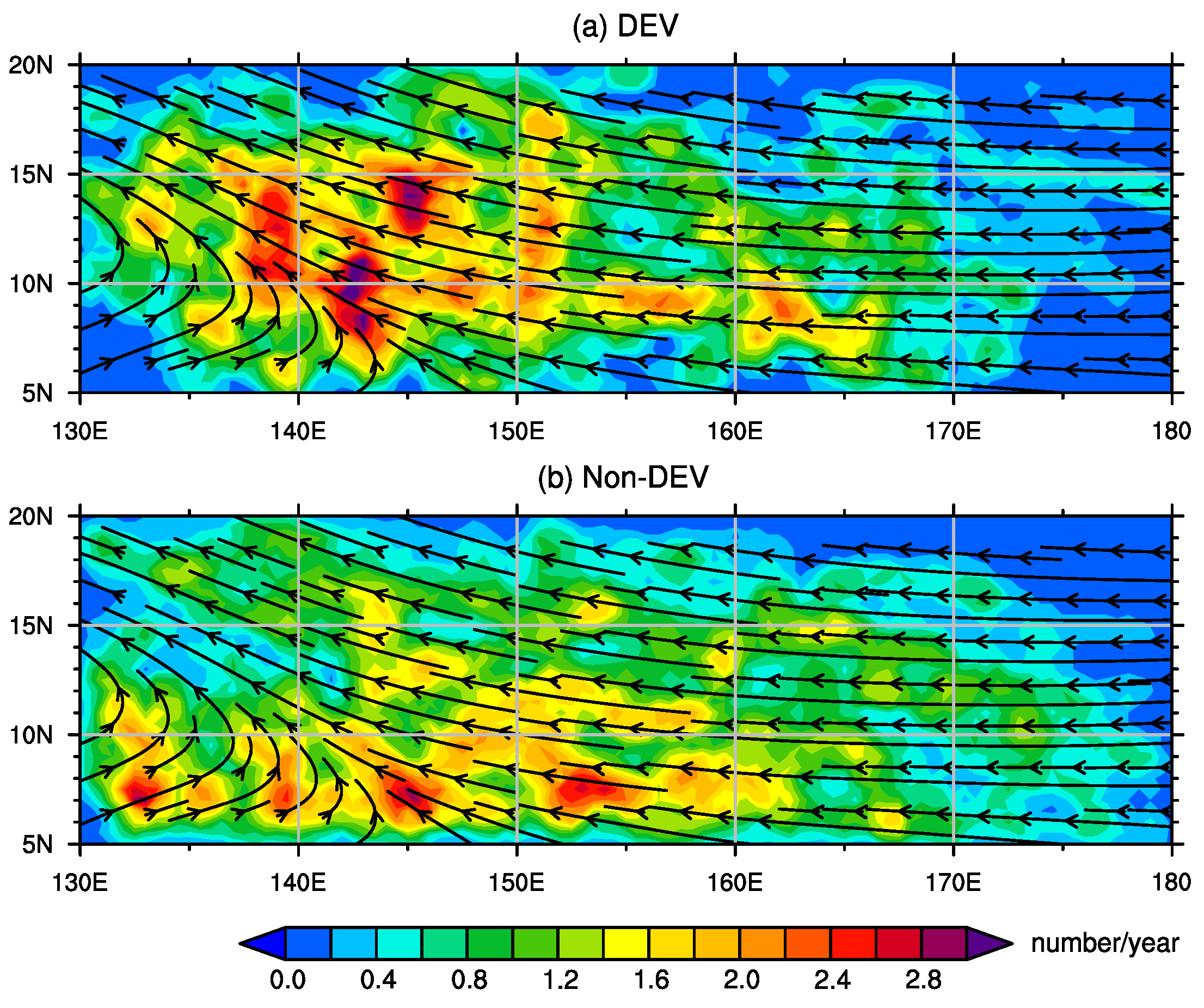
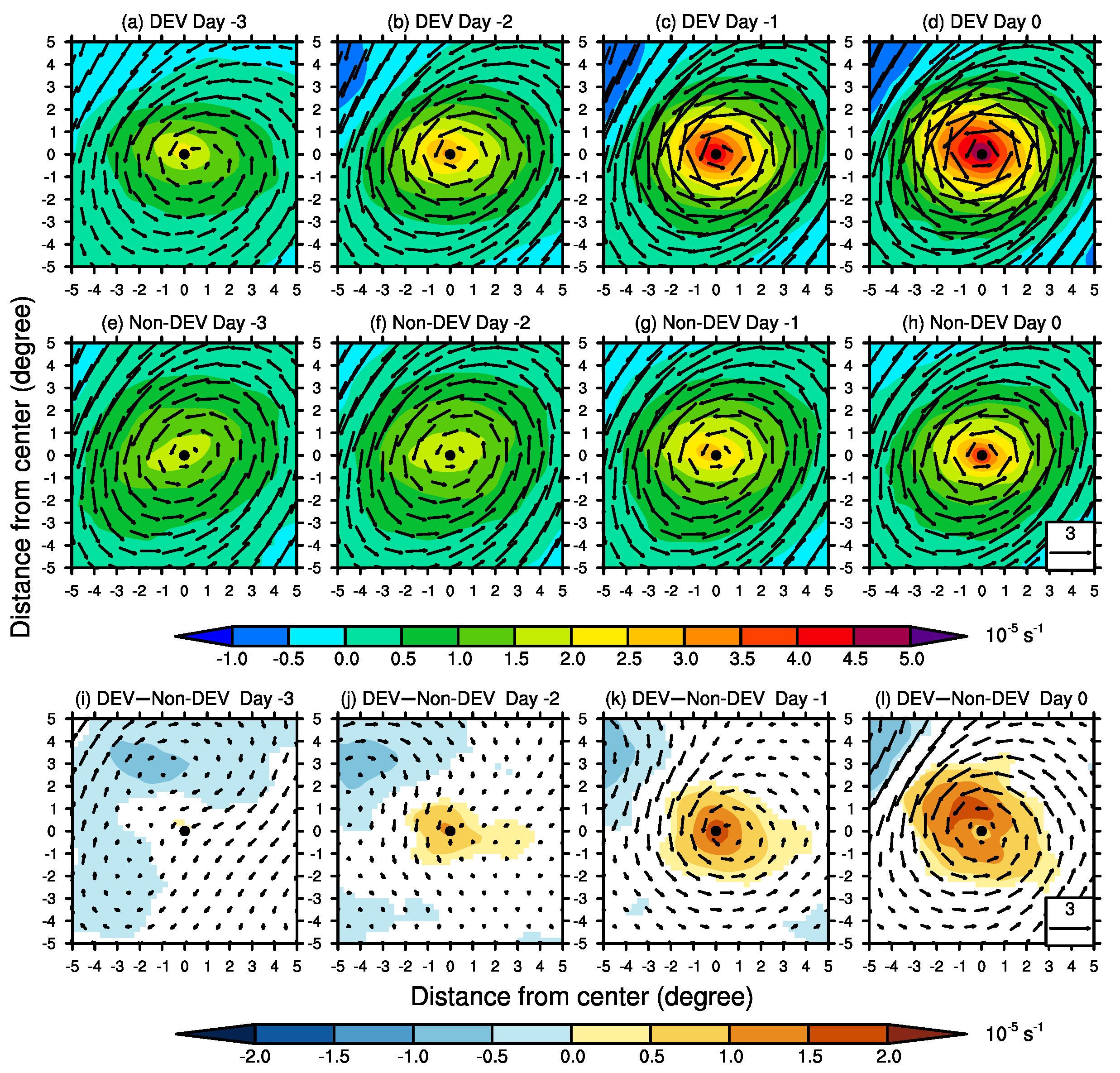
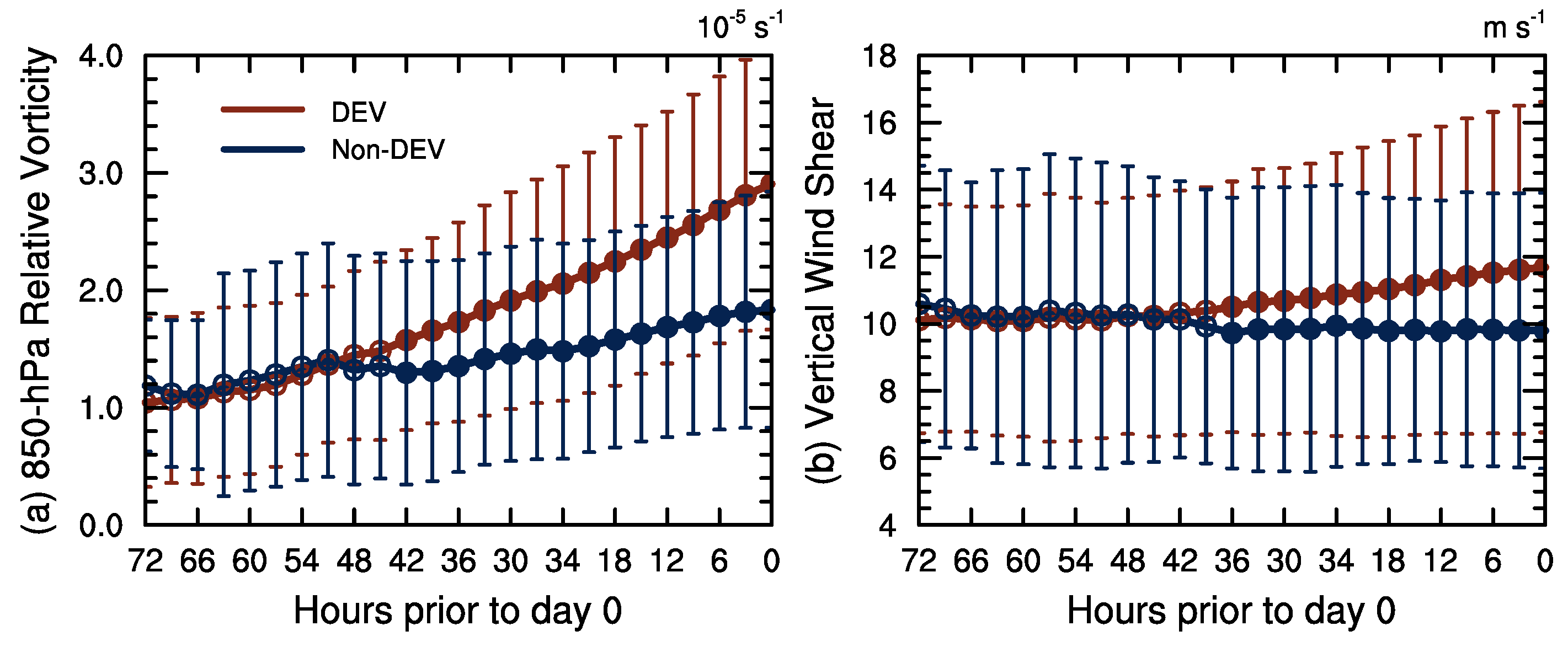
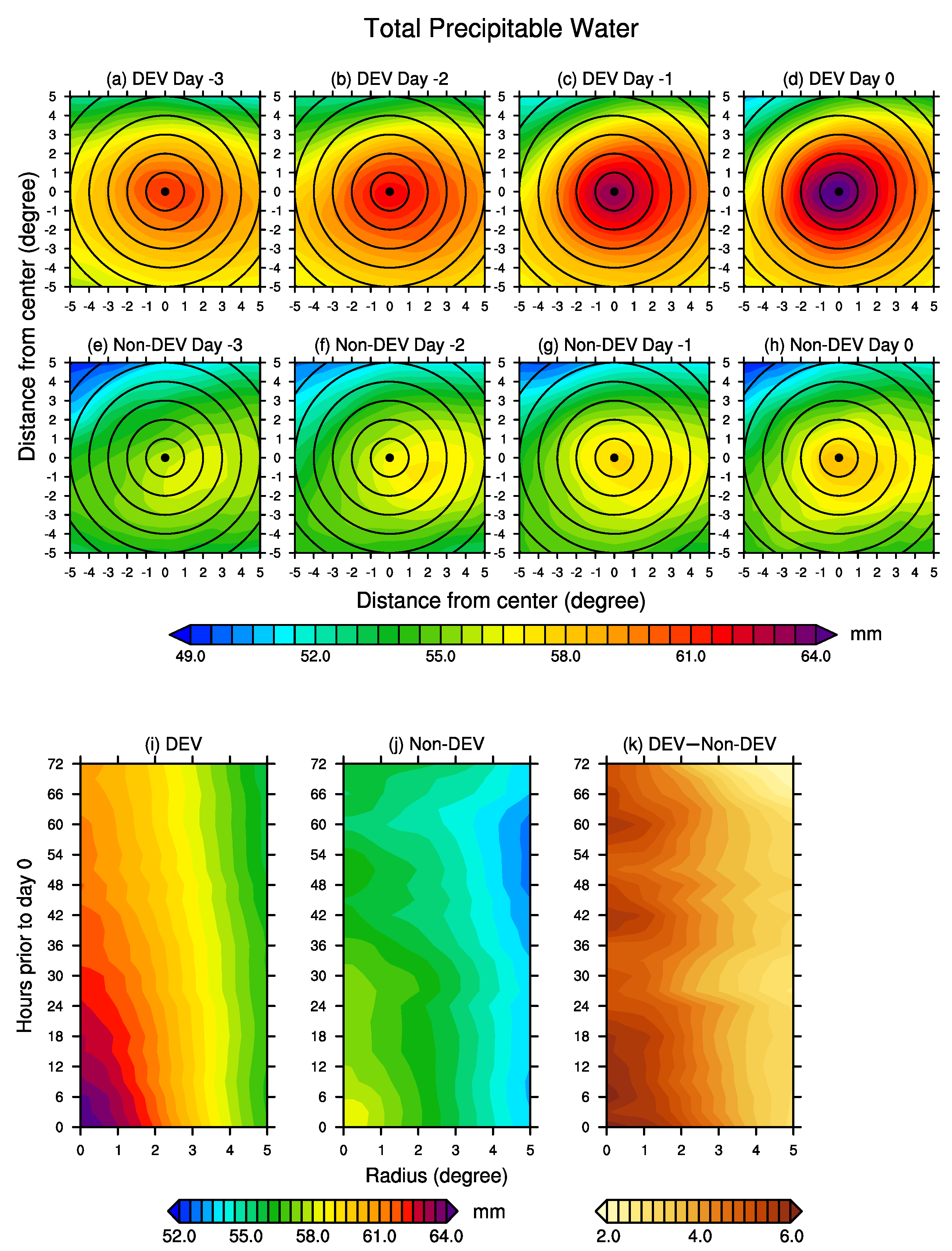
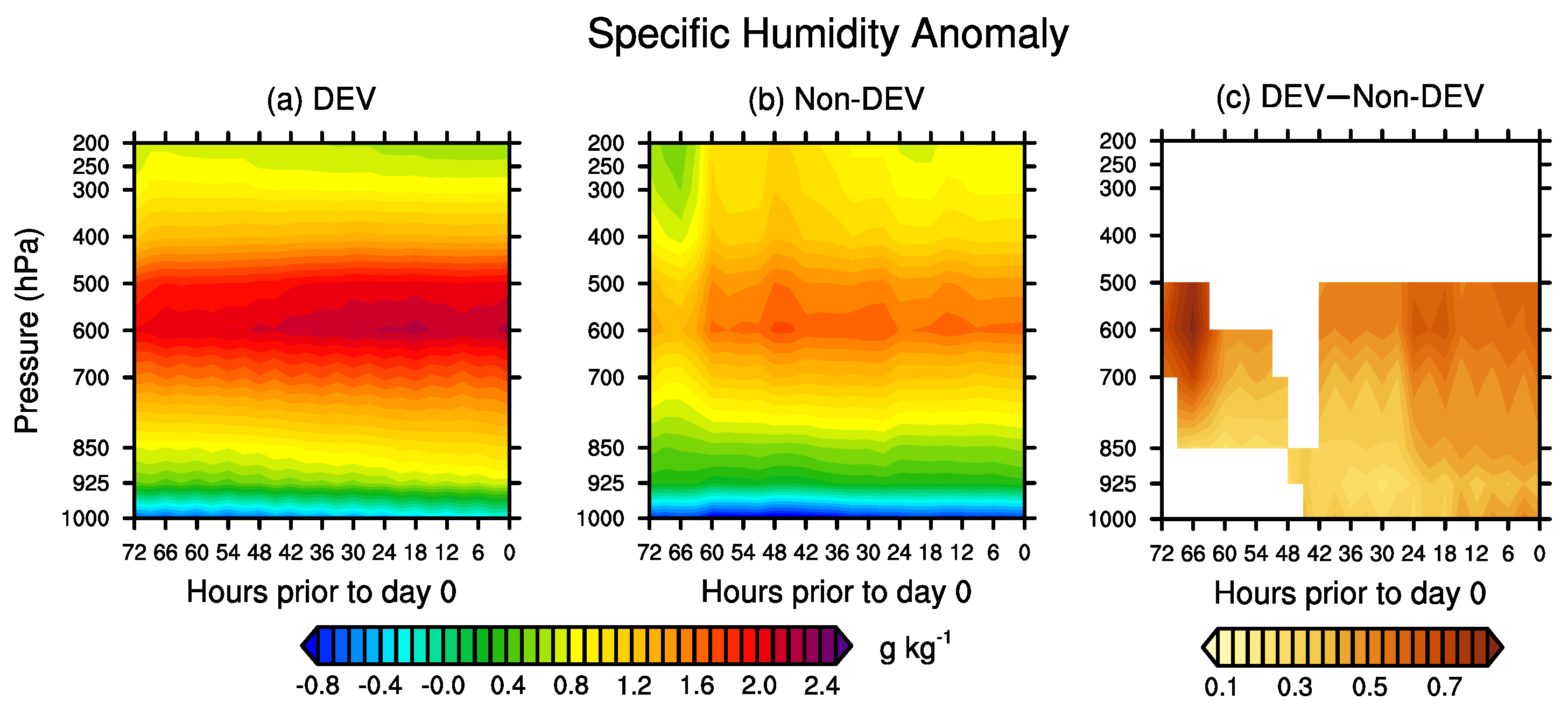



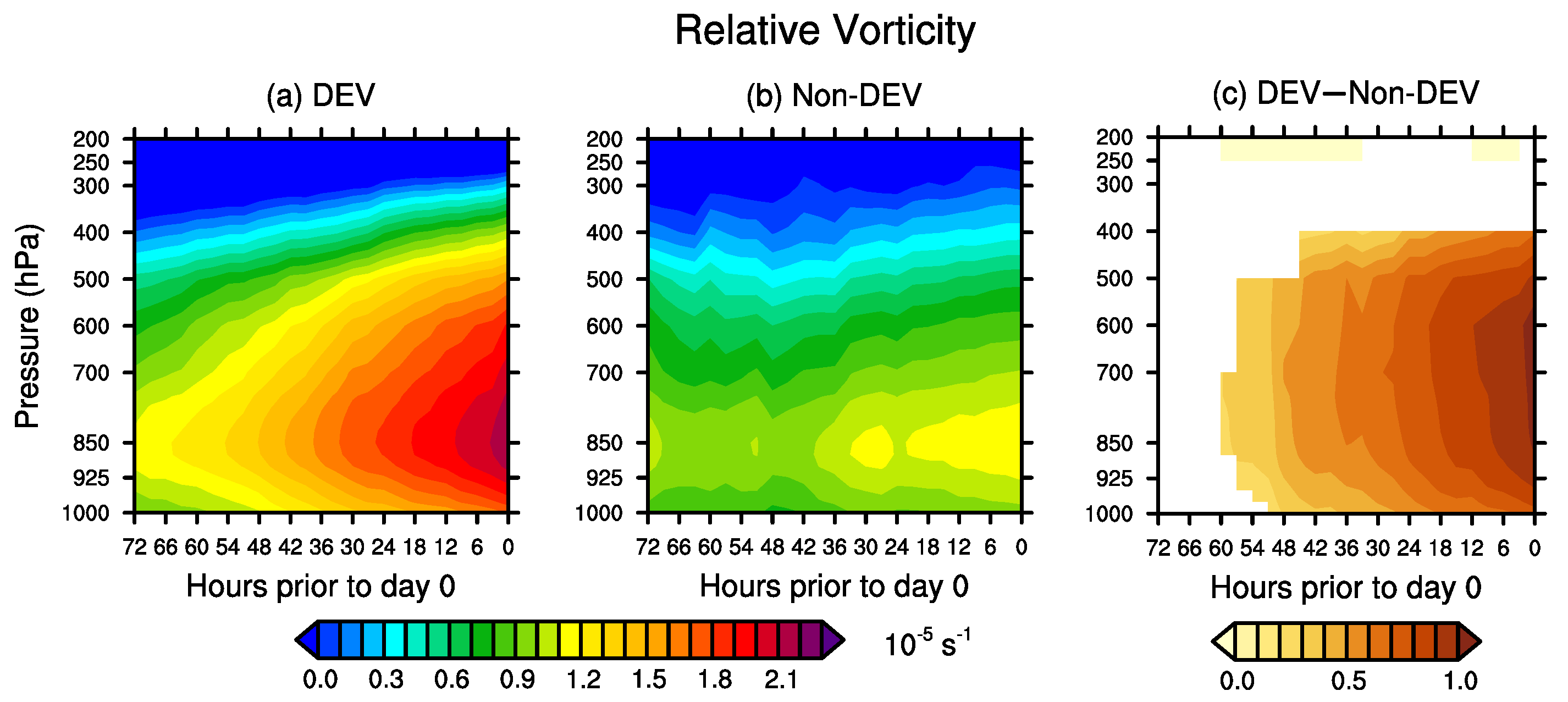
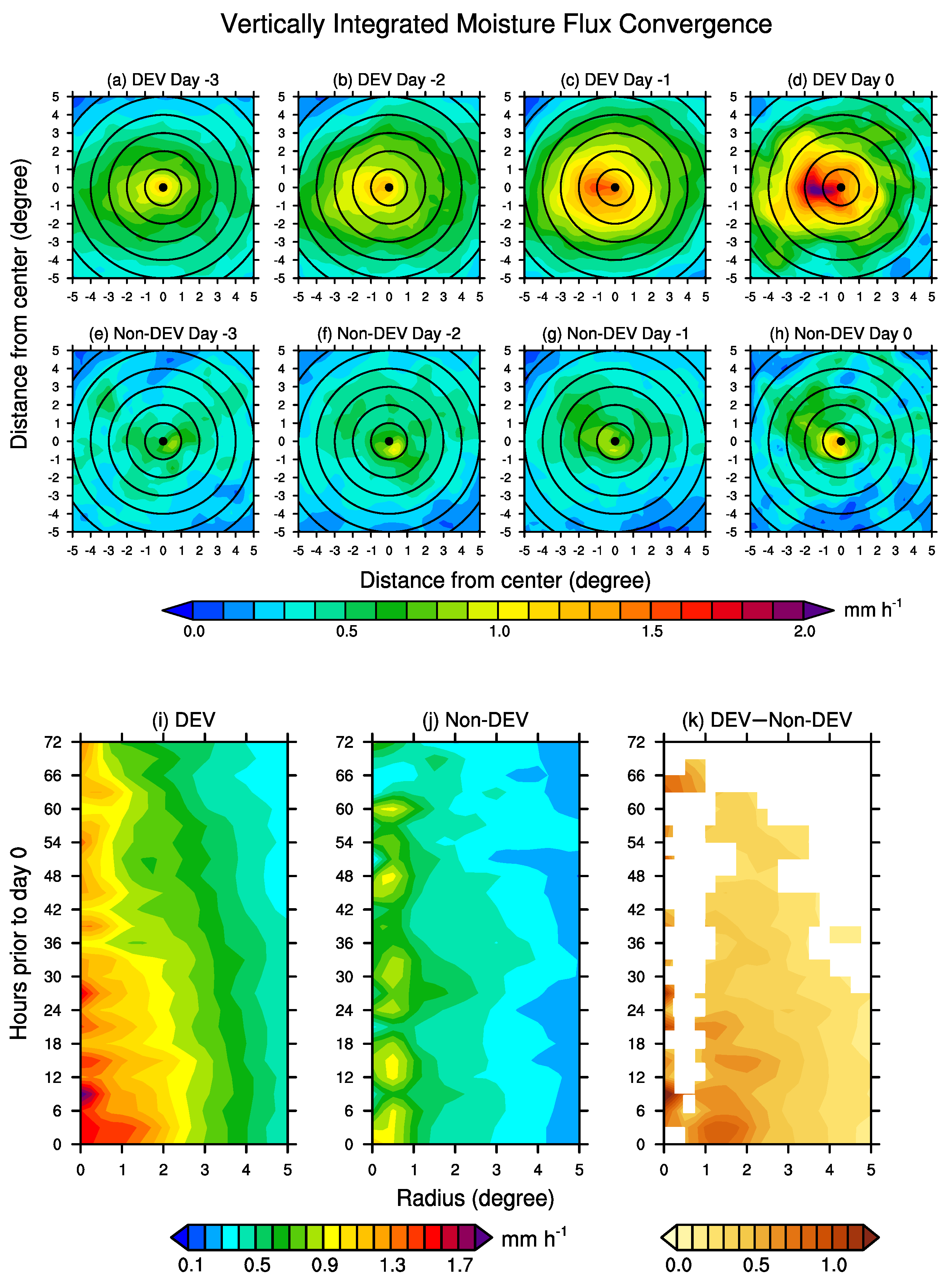
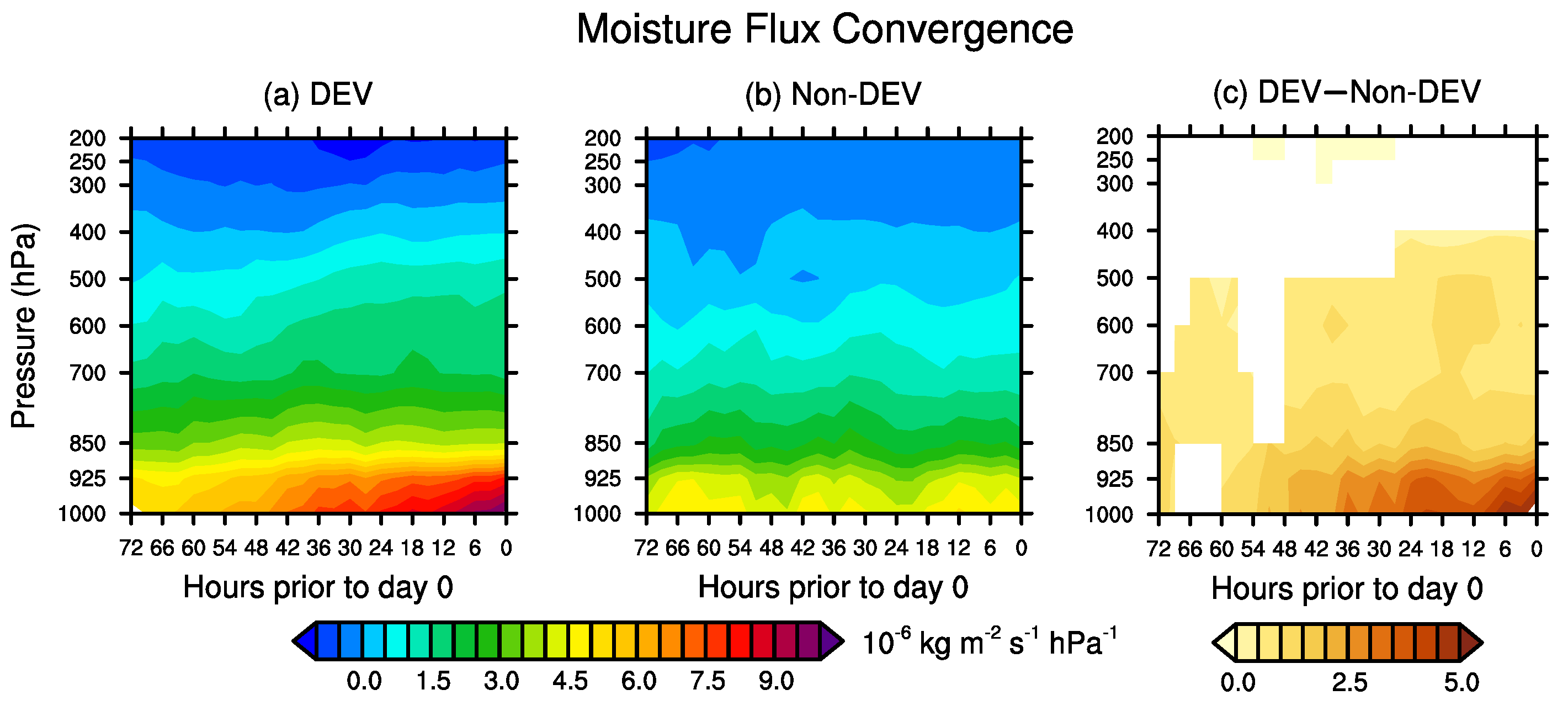
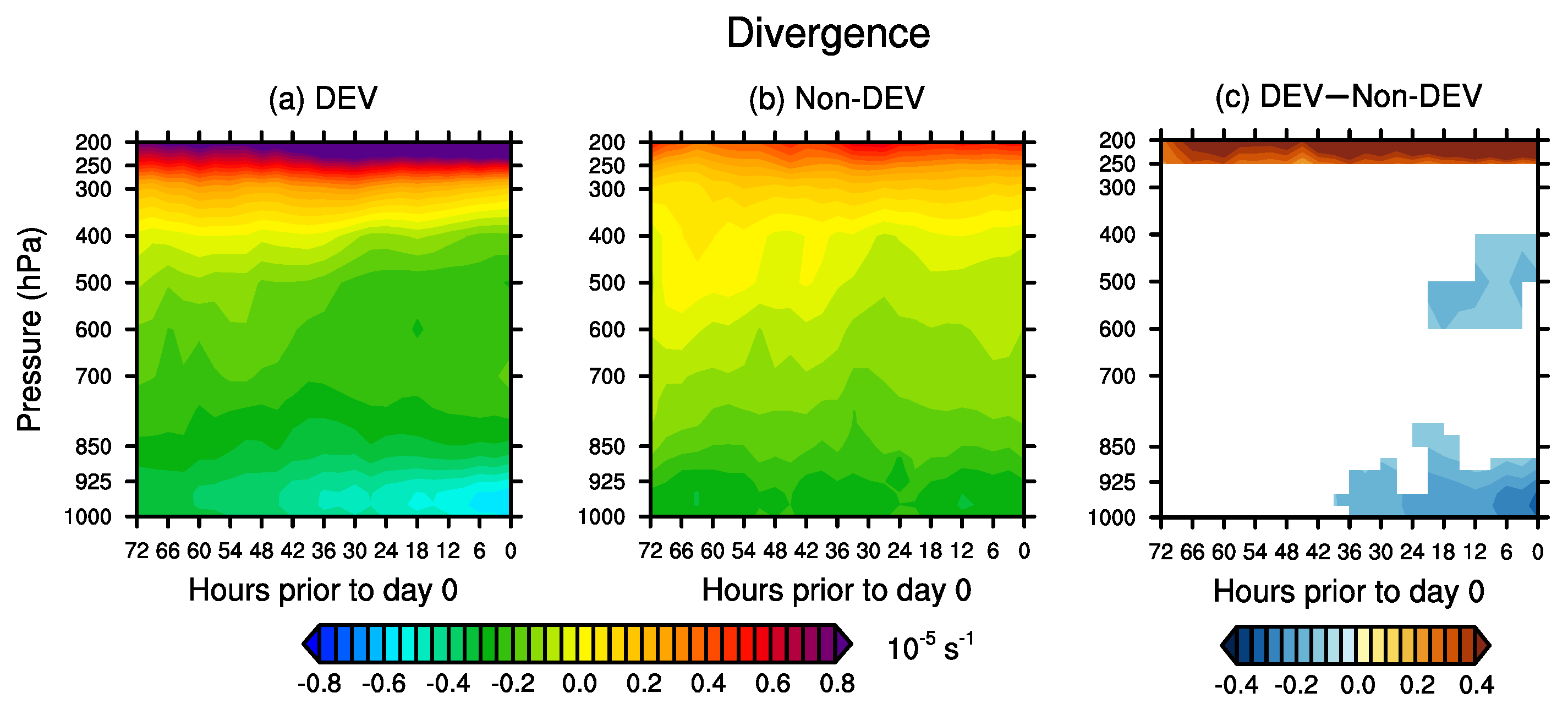
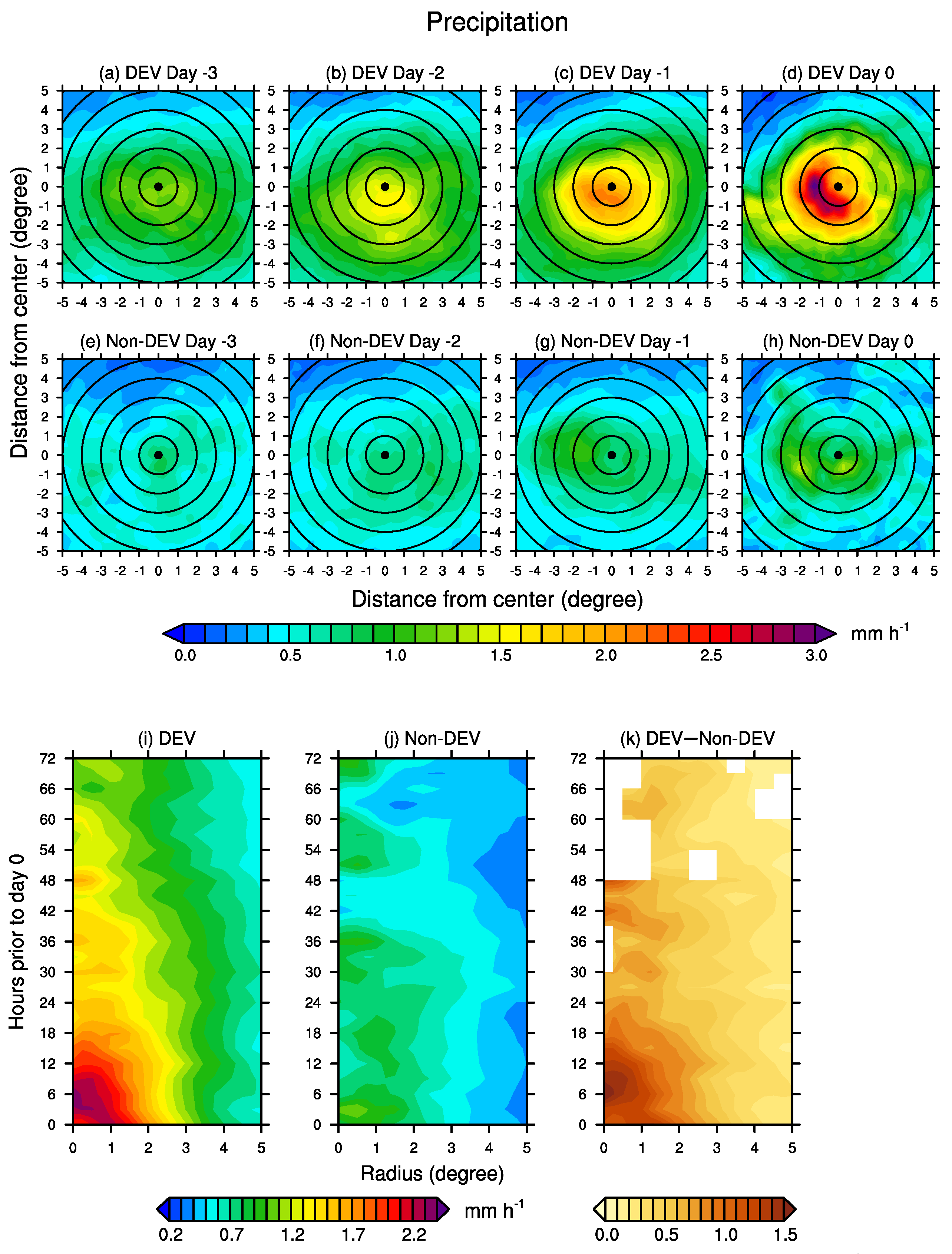
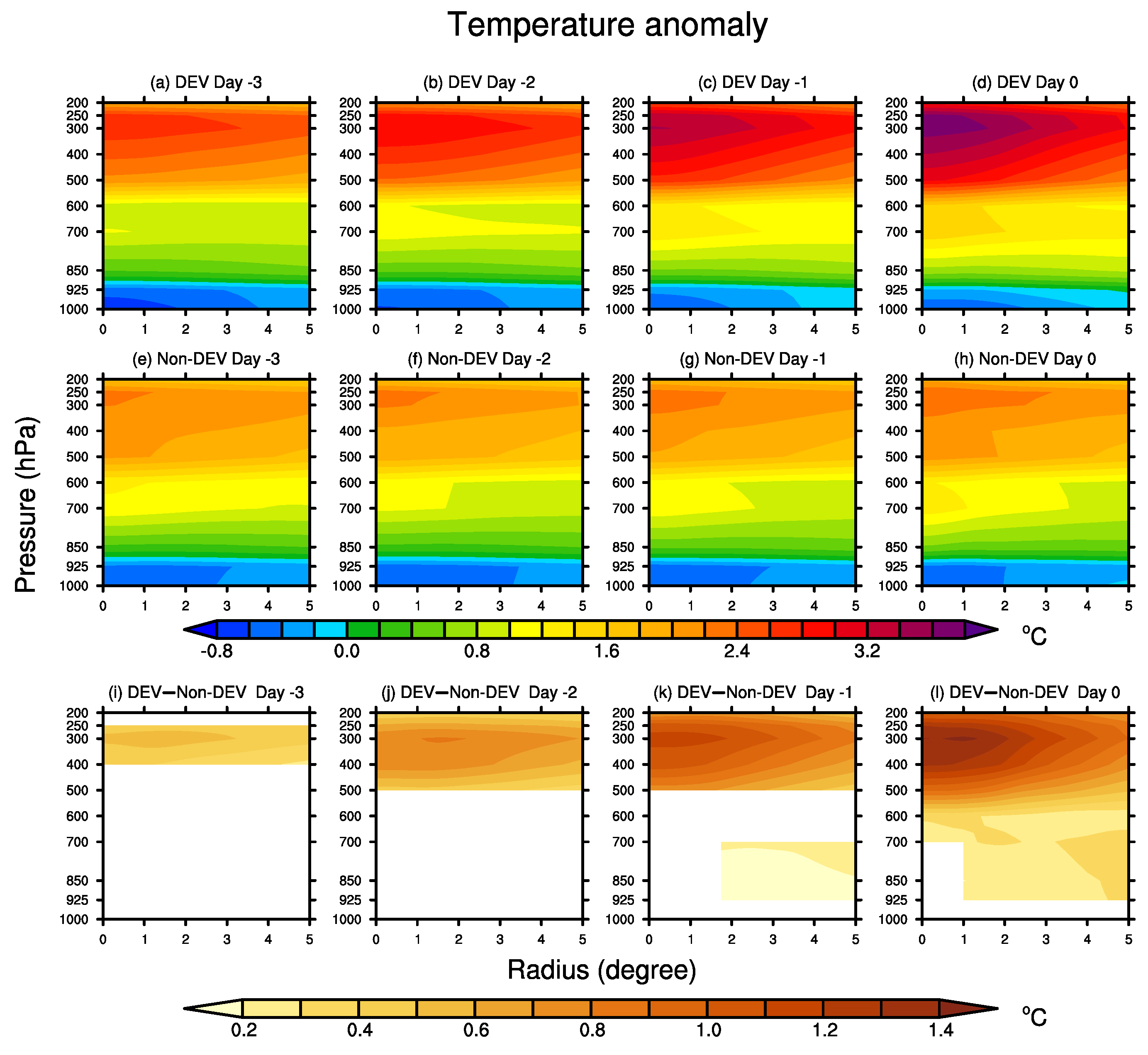
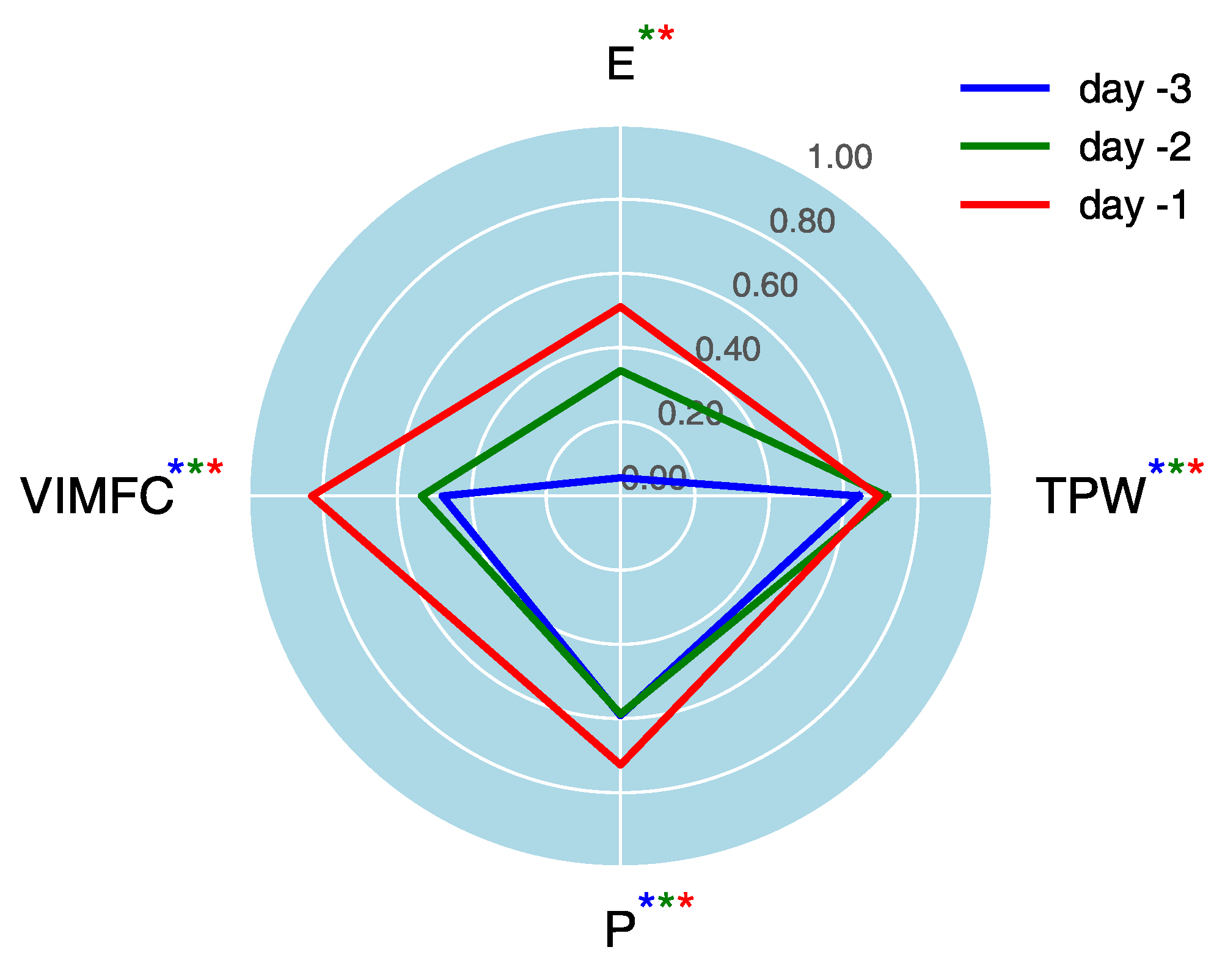
Disclaimer/Publisher’s Note: The statements, opinions and data contained in all publications are solely those of the individual author(s) and contributor(s) and not of MDPI and/or the editor(s). MDPI and/or the editor(s) disclaim responsibility for any injury to people or property resulting from any ideas, methods, instructions or products referred to in the content. |
© 2024 by the authors. Licensee MDPI, Basel, Switzerland. This article is an open access article distributed under the terms and conditions of the Creative Commons Attribution (CC BY) license (https://creativecommons.org/licenses/by/4.0/).
Share and Cite
Sun, Z.; Gao, S.; Jian, M. Comparison of the Water Vapor Budget Evolution of Developing and Non-Developing Disturbances over the Western North Pacific. Remote Sens. 2024, 16, 2396. https://doi.org/10.3390/rs16132396
Sun Z, Gao S, Jian M. Comparison of the Water Vapor Budget Evolution of Developing and Non-Developing Disturbances over the Western North Pacific. Remote Sensing. 2024; 16(13):2396. https://doi.org/10.3390/rs16132396
Chicago/Turabian StyleSun, Zhihong, Si Gao, and Maoqiu Jian. 2024. "Comparison of the Water Vapor Budget Evolution of Developing and Non-Developing Disturbances over the Western North Pacific" Remote Sensing 16, no. 13: 2396. https://doi.org/10.3390/rs16132396
APA StyleSun, Z., Gao, S., & Jian, M. (2024). Comparison of the Water Vapor Budget Evolution of Developing and Non-Developing Disturbances over the Western North Pacific. Remote Sensing, 16(13), 2396. https://doi.org/10.3390/rs16132396






